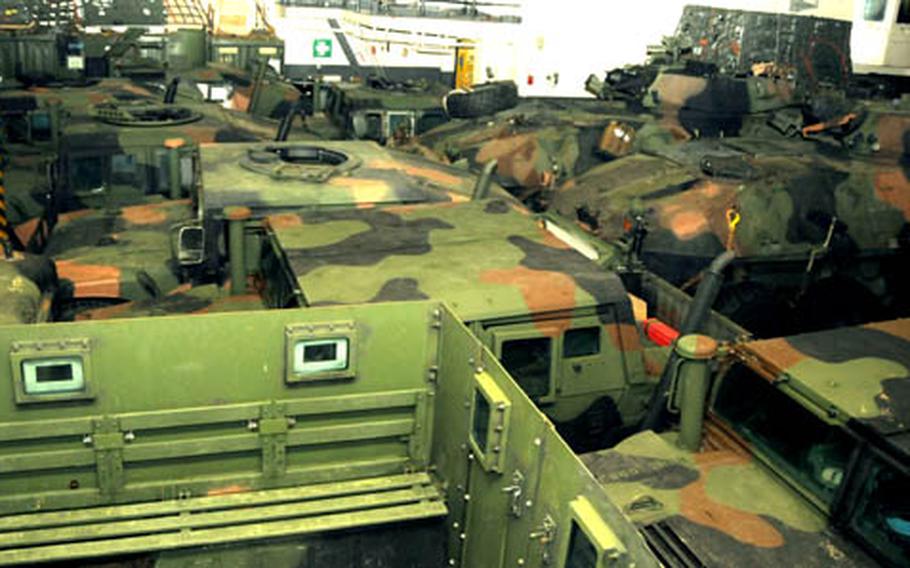
Vehicles are packed as tightly as possible into a storage space aboard the USS Essex, which is off Okinawa's shore. (Cindy Fisher / Stars and Stripes)
Related articles: Marines discover crowds help pass all that downtimeServicemembers find it’s easy to get sick round the USS Essex
ABOARD THE USS ESSEX — It’s a small, floating city run by about 1,100 sailors.
And when close to 1,000 Marines come aboard, the city comes alive.
“It’s crowded,” boatswain mate Petty Officer 3rd Class Daniel Merwin, 23, said Tuesday aboard the Essex as sailors and Marines moved about the ship. “You just have to accommodate it.”
For Seaman Charlene Moorehead, it seems that “the boat gets smaller,” she said.
“It’s three times the work and twice the mouths to feed,” Moorehead, a cook, said.
The Essex, USS Harpers Ferry, USS Juneau and USS Tortuga arrived at Okinawa on Jan. 28 from Sasebo Naval Base, Japan, and began boarding the Marines and more than 1,500 tons of cargo and equipment.
With Marines onboard Essex, the galleys serve more than 7,600 meals a day. That adds up to about 125 pounds of fresh vegetables, 370 pounds of fresh fruit and 2,200 pounds of meat consumed daily, according to Essex statistics. Marines and sailors will also drink more than 1,900 sodas daily.
The Essex spends three times more on food daily — from $10,000 to $30,000 — when Marines arrive, Chief Warrant Officer Mark Harrington, the ship’s food service officer, said in a news release.
“It’s a little hectic,” said Petty Officer 2nd Class Ryan Briggs, 24, who is thankful Marine cooks join the galley crew to help keep everyone fed.
The galley isn’t the only place that gets busier.
The ship’s store sees a lot more business, said Petty Officer 3rd Class Borris Laroach, 20.
To stock the little store, which sells snacks, noodles, hygiene supplies and other convenience items, for just Essex sailors, they load up about 80 pallets of goods, Laroach said.
In preparation for the Marines’ arrival, they brought on 180 pallets of goods, he said.
The store normally pulls in about $400 a day, but when the Marines are here, the store makes about $5,000 a day, he said.
Sailors in the ship’s post office also have their hands full.
One of the most important cargos for servicemembers is incoming mail, which doubles when the expeditionary troops come aboard, said Chief Petty Officer Mike Kinstle, the postal officer.
He has found that the advent of e-mail has not decreased the amount of mail the ship receives. It just means a higher percentage of packages, he said.
Mail is delivered by whatever means possible — helicopter, landing craft utility and even landing craft air cushioned — whenever they can manage it, Kinstle said.
The crew unloaded about 1,500 pounds of mail Tuesday, which was a couple of days worth, he said. For Valentine’s Day he said he expected to get 10 times that.
Including the 31st Marine Expeditionary Unit in shipboard life means more work for everyone, but the Marines pitch in and help, sailors said.
And it’s worth the extra work, said Petty Officer 1st Class Guy Dickantone, 40, the enlisted leader for the ship’s power plants section.
He said he has found that working with the Marines is a good way to exchange knowledge about working on different types of aircraft.
The Essex Expeditionary Strike Group was scheduled to depart the waters off Okinawa on Thursday to head for the Philippines, where the 31st MEU will participate in the Balikatan 2008 exercise from Monday to March 3.